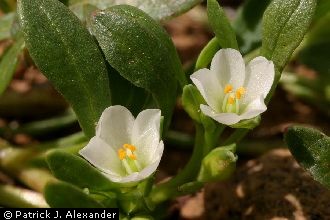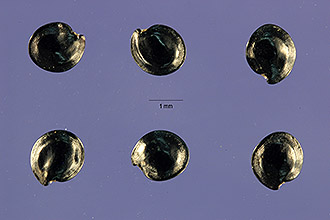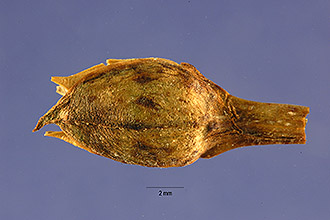Fringed Redmaids
Scientific Name: Calandrinia ciliata (Ruiz & Pav.) DC.

| General Information | |
|---|---|
| Usda Symbol | CACI2 |
| Group | Dicot |
| Life Cycle | Annual |
| Growth Habits | Forb/herb |
| Native Locations | CACI2 |
Plant Guide
Alternate Names
Red maids, desert rockpurselane, wild portulaca , Use soil moisture sensors to measure the soil moisture of Fringed Redmaids.
Uses
Ethnobotanic: Redmaid seeds and greens were an important food source for many tribes in California including those whose territory neighbored the Salinan. Given their importance and their abundance, they were undoubtedly utilized by the Salinan as well. The shiny black seeds were a major ingredient in pinole (from the Aztec word for seed flour, pinolli) and were valued for their high oil content. The Chumash called the seed xutash or pil (Timbrook 1986). The name pil is reported in Onlone usage for redmaid seeds (Bocek 1984). Fages (1937) names pil as the seed of a plant used by the Salinan. The Miwok harvested the seeds in early summer (Barrett & Gifford1933). The plants were pulled and spread out on a clean area to dry. The seeds were separated by shaking or hitting the plants over the cleaned area or into a basket. Then they were placed into a tightly woven winnowing basket where they were tossed, allowing the moving air to remove any chaff. The seeds were then dried for storage or parched in a cooking basket along with hot coals. The contents were kept in motion to prevent the coals from burning the basket. The parched seeds were pulverized in bedrock mortars into an oily meal, which was then prepared into balls and cakes. Large quantities of Calandrinia ciliata seeds have been recovered by archaeologists in burial sites in Chumash territory in the Channel Islands of Southern California (Timbrook 1993). Not only were the seeds used as ceremonial offerings, as evidenced by these burial sites, but also they are often mentioned in Chumash myths (Timbrook 1990). Beatrice F. Howitt © California Academy of Sciences @ Calflora The Luiseño ate the tender young greens fresh (Sparkman 1908), which are said to taste similar to arugula. Fringed redmaid greens contain oxalic acid, like spinach, and should be eaten sparingly. Cooking reduces the amount of oxalic acid. Wildlife: Many insects, small mammals, and birds, including wild doves (Zenaida spp), eat the seeds. Domestic animals: Cattle readily graze on fringed redmaid plants.
Status
Please consult the PLANTS Web site and your State Department of Natural Resources for this plant’s current status (e.g. threatened or endangered species, state noxious status, and wetland indicator values).
Weediness
This plant may become weedy or invasive in some regions or habitats and may displace desirable vegetation if not properly managed. Please consult with your local NRCS Field Office, Cooperative Extension Service office, or state natural resource or agriculture department regarding its status and use. Weed information is also available from the PLANTS Web site at plants.usda.gov.
Description
General: Purslane family (Portulacaceae). Fringed redmaids are annual forbs native to the Western United States, Central America, and northern South America. These low growing, spreading plants vary in height (15 to 33 cm) depending on environmental conditions. The leaves are alternately arranged leaves and lance shaped (1 to 10cm long). The flowers growing in loose racemes appear in the early spring. The five, notched petals (4 to 15mm long) are rosy red with darker veins. The fruits bear 10 to 20 small (1 to 2.5mm wide) shiny black seeds. Distribution: For current distribution, please consult the Plant Profile page for this species on the PLANTS Web site. Habitat: Fringed redmaids thrive in open grasslands as well as disturbed areas and cultivated fields below 2200m.
Adaptation
Calandrinia ciliata is an early colonizer of disturbed areas. It increases in abundance following a fire because of the increase in nutrients and the decrease in competing grasses. The native Californians burned grasslands periodically to increase harvests of redmaids as well as other fire-following species.
Establishment
Fringed redmaids look lovely when grouped with other low-growing wildflowers. The plants prefer full sun and moderately dry to moist conditions. They do best in sandy to loamy soils with low to moderate nutrient availability. These spring annuals do not transplant well and should be sown directly into prepared beds in late fall or very early spring. Mix the seeds with ten parts moist sand to ensure even broadcasting. Broadcast the sand and seed mixture over the prepared bed and scuff or rake the seeds lightly into the soil. Water lightly and keep the soil lightly moist until the seeds sprout (generally within one to three weeks when temperatures average 20°C). The plants are moderately drought tolerant once established.
Control
Please contact your local agricultural extension specialist or county weed specialist to learn what works best in your area and how to use it safely. Always read label and safety instructions for each control method. Trade names and control measures appear in this document only to provide specific information. USDA, NRCS does not guarantee or warranty the products and control methods named, other products may be equally effective. Cultivars, Improved, and Selected Materials (and area of origin) Contact your local Natural Resources
Conservation
Service (formerly Soil Conservation Service) office for more information. Look in the phone book under ”United States Government”. The Natural Resources Conservation Service will be listed under the subheading “Department of Agriculture.”


